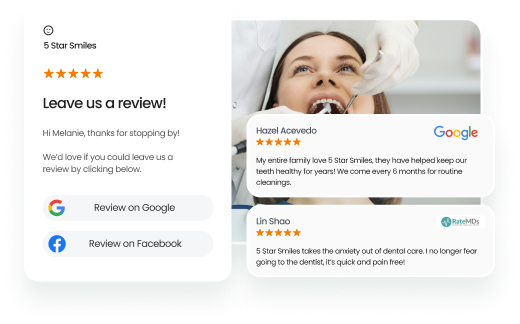Customer touchpoints are the moments when people encounter your brand, whether it’s an ad that catches their eye, visiting your website, reading online reviews, or interacting with your sales team.
Have you ever stopped to think about how those interactions make your customers feel? Are they smiling with satisfaction or scratching their heads in confusion?
When everything flows smoothly and the customer journey is great, they’re likely to return for more. However, if things become tricky or frustrating, they could simply head out the door.
So, are your touchpoints making your customers happy, or is it time for a little refresh? Let’s make sure those moments are working for you and turning first-time visitors into repeat customers.
In this blog, you’ll learn what customer touchpoints are, why they matter, how to identify them, and how brands like South Georgia Dental use Birdeye to transform them into growth drivers.
Remember: Touchpoints are the bridge to brand trust. Nail them, and you unlock higher customer satisfaction, loyalty, and growth.
Table of contents
- What are customer touchpoints?
- Why are customer touchpoints important to your business?
- 23 Key customer touchpoints examples that drive conversion and loyalty
- Examples of customer touchpoints before a purchase
- Examples of customer touchpoints during a purchase
- Post-purchase touchpoints: Turning one-time buyers into loyal customers
- Customer service touchpoints that impact retention
- How Birdeye helped South Georgia Dental optimize touchpoints
- How to identify customer touchpoints in your business
- How to build an effective customer touchpoint strategy for growth
- Leverage Birdeye solutions to scale touchpoint success
- FAQs: Everything you need to know about customer touchpoints
- Harness the power of touchpoints to accelerate business growth
What are customer touchpoints?
Customer touchpoints refer to any moment when a customer interacts with your business, whether directly or indirectly, before, during, or after a purchase. These include digital experiences, such as visiting your website, offline moments, like chatting with a sales representative, or even indirect touchpoints, like reading third-party online reviews.
Each touchpoint plays a role in shaping customers’ perception, influencing buying decisions, and ultimately defining the overall customer experience. They’re not just steps in a process; they’re moments that build (or break) trust.
Tip: When you view your customer journey touchpoints as opportunities to create value, instead of checkpoints, you start delivering experiences that drive loyalty, revenue, and growth.
Why are customer touchpoints important to your business?
Customer touchpoints are key opportunities to shape how people perceive your brand. Every time a customer engages with your brand, it’s an opportunity to strengthen that connection and build your online reputation.
Here’s why these moments are so impactful:
- According to McKinsey & Company, offering a personalized customer experience can lead to up to a 40% higher revenue. Imagine the growth potential when every interaction works in your favor!
- PwC reveals that a positive customer experience can increase spending by up to 16%, but here’s the catch: one bad experience can drive away 17% of your customers permanently. That’s a significant loss.
Touchpoints influence every stage of the customer journey. Well-managed ones foster engagement, loyalty, and repeat business.
Poorly handled touchpoints, on the other hand, lead to disengagement, negative reviews, and lost revenue. Therefore, strategically managing the customer touchpoints is essential to influence customer behavior and drive brand loyalty.
For example, sales reps engaging with customers at critical moments can either accelerate or derail a sale. Likewise, interactions on social media, whether through direct messages or posts, can build trust or, if mishandled, create skepticism. Every interaction counts, and ignoring or mishandling key touchpoints can lead to poor customer satisfaction and tarnish your brand’s reputation.
Pro Tip: Don’t just look at individual touchpoints. Map how customers feel across a touchpoint's customer journey. That’s where the real insight lies.
23 Key customer touchpoints examples that drive conversion and loyalty
Before, during, and after a purchase, customer touchpoints shape the overall experience and influence critical business outcomes.
These moments provide brands with an opportunity to engage, build trust, and encourage conversions, ultimately contributing to brand loyalty and long-term success.
Here are 23 examples of crucial customer touchpoints, both before, during, and after a purchase, that showcase how strategic interactions can boost customer satisfaction and enhance conversion rates.
Examples of customer touchpoints before a purchase
These important customer touchpoints are where potential customers first interact with your brand, and each one holds the power to influence their decision-making process.
Here’s a closer look at these critical customer contact points:
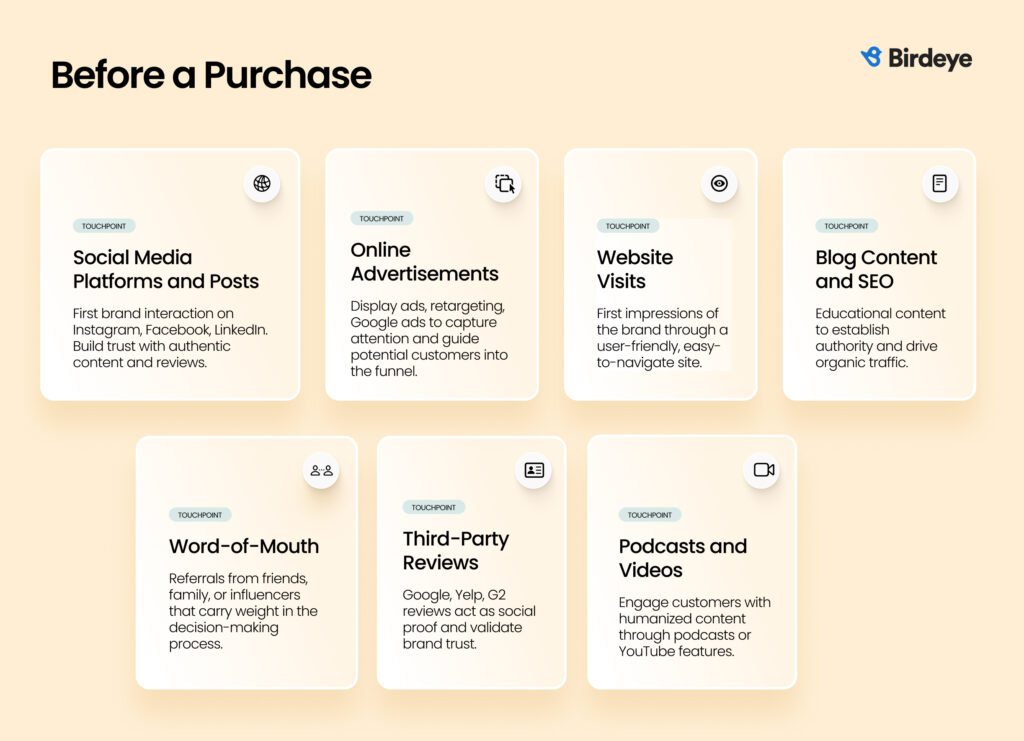
1. Social media platforms and posts
Your social media channels, such as Instagram, Facebook, and LinkedIn, are often the first places where new customers encounter your brand. By sharing authentic content, engaging with customer comments, and posting review snippets, you can build early trust and credibility. These touchpoints allow customers to quickly gauge whether your brand aligns with their values.
2. Online advertisements
Display ads, retargeting banners, and Google search ads are highly effective at capturing attention and drawing potential customers into your funnel. These ads not only reinforce your brand’s visibility but also create a clear call-to-action that directs customers toward a conversion point, often offering them something of value at the moment they need it most.
3. Website visits
When customers first visit your website, whether from an ad, search result, or social media post, it’s a crucial touchpoint in the awareness stage. A user-friendly and easy-to-navigate site makes a big difference in keeping them engaged. By providing clear, accessible information, you can increase customer satisfaction and set the stage for stronger relationships.
4. Blog content and SEO
Educational blog posts optimized for search engine optimization (SEO) are powerful tools for positioning your brand as a thought leader. Well-crafted content drives organic traffic by answering questions, solving problems, and addressing pain points. By aligning your blog content with what your target audience is searching for, you establish authority while generating valuable customer data to refine future campaigns.
5. Word-of-mouth
Referrals from friends, family, or influencers carry immense weight in building brand trust. Word-of-mouth recommendations drive high-converting traffic, as they come pre-loaded with customer trust. When a trusted individual vouches for your brand, it reduces friction and accelerates the decision-making process for potential customers.
6. Third-party reviews and forums
Customer feedback on platforms like Google, Yelp, and G2 acts as social proof and is a key touchpoint for new customers. Reviews from other consumers serve as a powerful endorsement, validating your brand’s reliability and trustworthiness.
Worth noting: According to the 2025 Birdeye State of Online Reviews, 81% of all reviews are on Google. To influence potential customers at these critical touchpoints, optimizing your Google Business Profile for visibility can make all the difference in attracting them.
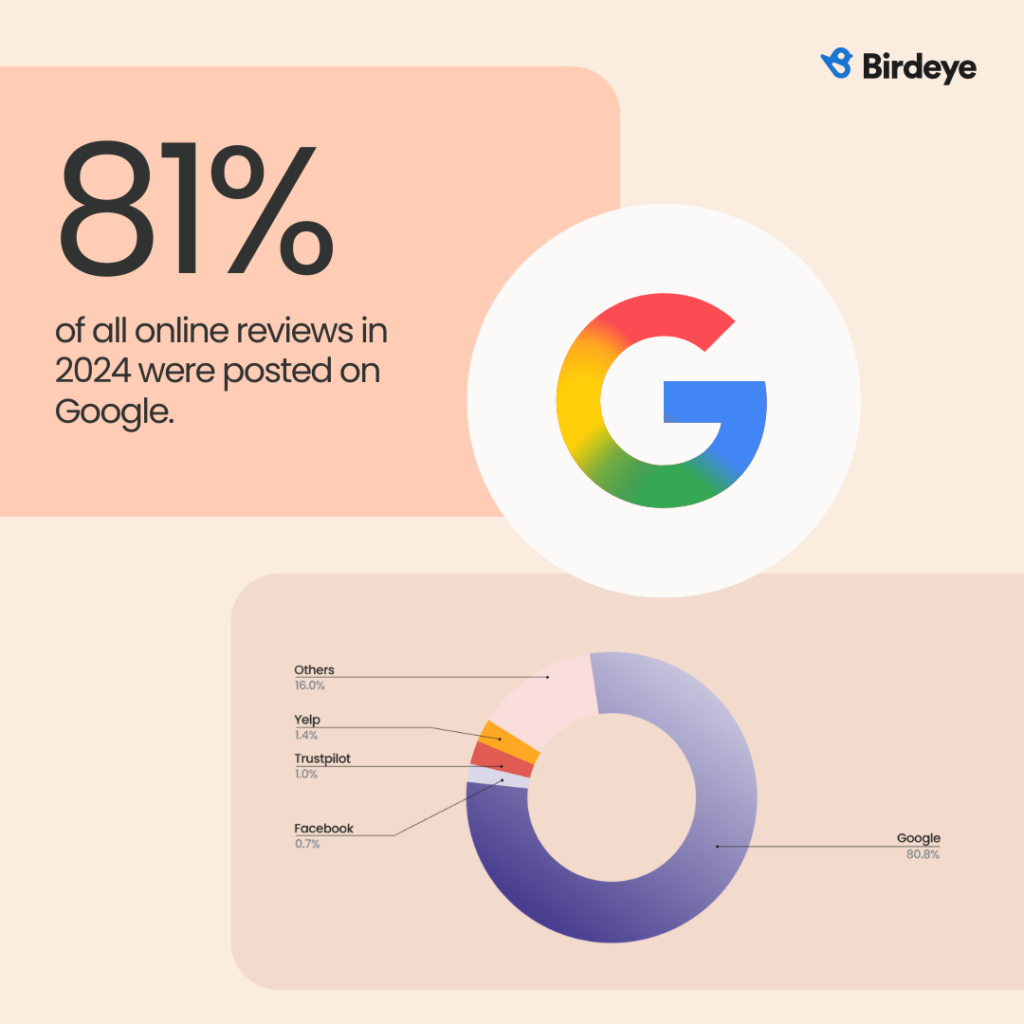
7. Podcasts and videos
Being featured on a podcast or YouTube series that resonates with your audience can significantly boost your brand’s visibility. These platforms serve as dynamic touchpoints that humanize your brand, offering deep connections through insightful conversations. Videos and podcasts enable customers to see and hear your values in action, creating a more memorable interaction than static content alone.
Examples of customer touchpoints during a purchase
The decision stage is crucial in determining whether a potential customer will complete their purchase. During this phase, customer interactions have a direct influence on the final decision.
Here are the key customer touchpoints that shape the customer’s journey:
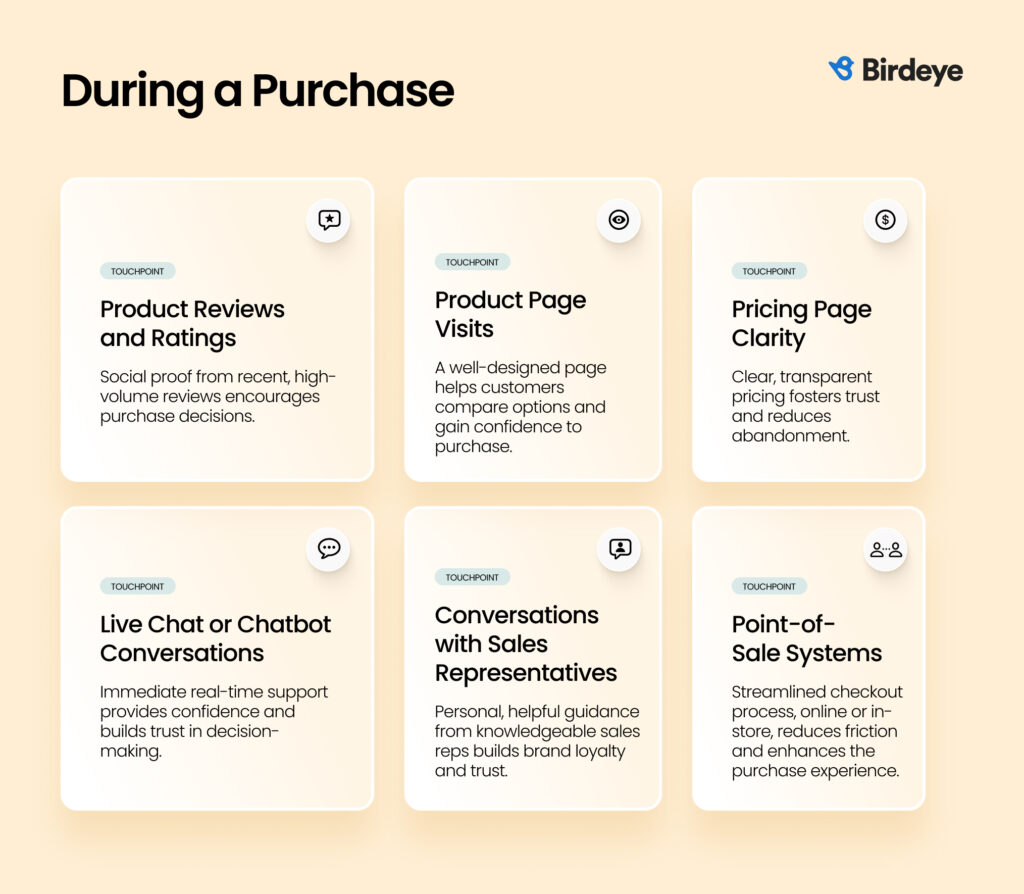
8. Product reviews and ratings
Recent and high-volume product reviews serve as social proof for new customers, encouraging them to complete their purchase. Positive reviews help to minimize doubts and provide a sense of security, especially when potential buyers see that others have had a positive experience.
Birdeye Tip: With Birdeye Reviews AI, brands can collect, respond, and analyze reviews at scale across 200+ sites, automatically surfacing trends and customer concerns that matter most.
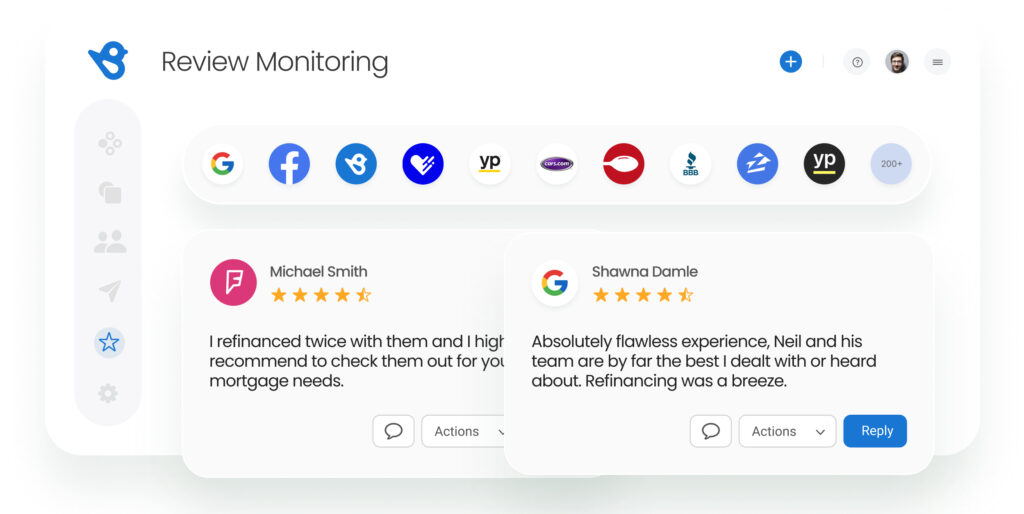
9. Product page visits
During the decision stage, customers revisit your site to explore product pages, compare options, and evaluate details. A well-designed page that highlights key features, benefits, and differentiators fosters trust and confidence. Optimizing these pages boosts customer satisfaction, drives conversions, and helps cultivate a loyal customer base, ensuring customers feel confident in their purchase decision.
10. Pricing page clarity
Your pricing page should be transparent and easy to navigate. A well-structured pricing page enables customers to easily compare plans, clearly see the value, and make informed decisions without unnecessary friction. A confusing or hidden price tag is a major barrier that causes potential buyers to abandon their carts, often leading them to rely more on your customer service team for clarity. Clear pricing builds trust and reduces the need for excessive support.
11. Live chat or chatbot conversations
Offering real-time support during the decision-making process is essential for addressing last-minute questions or concerns. Whether through live chat with a representative or an automated chatbot, these touchpoints provide immediate assistance, building urgency and confidence in the purchase. Fast, efficient communication is a key factor in enhancing the overall customer experience, making customers feel more comfortable and empowered to follow through.
12. Conversations with your sales representatives
Your sales reps are more than just closers; they are the face of your brand and your key ambassadors. Personalized, helpful guidance from a knowledgeable sales team can make all the difference. By listening to customer expectations and addressing concerns in real-time, sales representatives can build brand loyalty and seal the deal with confidence, helping existing customers feel valued and engaged.
13. Point-of-sale systems
Whether your customers make their purchase online or in a physical store, the point-of-sale experience must be flawless. Online checkouts should be fast, secure, and straightforward, while brick-and-mortar stores should provide a smooth, hassle-free counter experience. Payment delays or poor customer service during this step create frustration and lead to cart abandonment. Streamlining this step ensures that the purchase process is quick and stress-free.
Post-purchase touchpoints: Turning one-time buyers into loyal customers
Post-purchase touchpoints play a crucial role in determining whether a potential customer becomes a one-time buyer or a long-term, loyal brand supporter. These moments after a transaction can either foster brand loyalty or push the customer away.
Here’s how you can optimize these touchpoints to build a strong, lasting relationship with your customers:
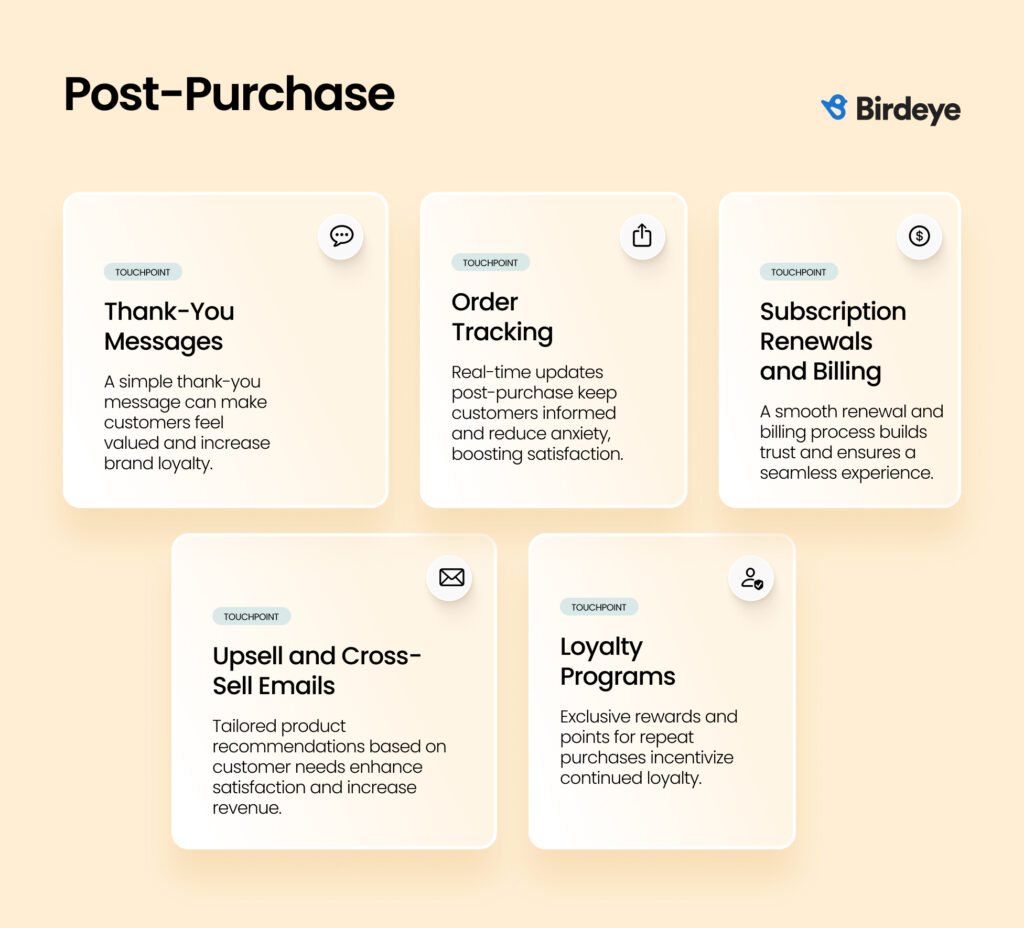
14. Thank-you messages
A thank-you email, handwritten note, a social media shout-out, or even a direct message may seem simple, but they carry profound value. Showing genuine appreciation for a customer’s purchase helps create an emotional connection. This small gesture can transform an ordinary transaction into a memorable experience. It sets the stage for brand loyalty and increases the likelihood that they’ll return to interact with your brand again.
15. Order Tracking
After sending a thank-you message, another key post-purchase touchpoint is order tracking and delivery updates, especially in e-commerce or subscription businesses. Customers increasingly expect real-time updates on their orders, and keeping them informed throughout the process can significantly boost customer satisfaction. Timely and transparent delivery notifications not only reduce anxiety but also build trust, making customers feel valued and more likely to return for future purchases.
16. Subscription renewals and billing
Subscription renewals and billing processes must be seamless, transparent, and error-free. A smooth renewal process shows that you respect the customer’s time and money, ensuring they feel confident in continuing their relationship with your brand. For subscription-based and retail models alike, a smooth billing experience is crucial. Hence, ensure your payment methods and follow-up communications are simple, easy to navigate, and transparent.
Pro Tip: With Birdeye Payments, you can easily streamline your payment process. Offer multiple payment options, enjoy transparent flat fees with no hidden costs, and ensure top-notch security with Stripe’s PCI compliance and early fraud detection. Get paid faster and keep transactions hassle-free.
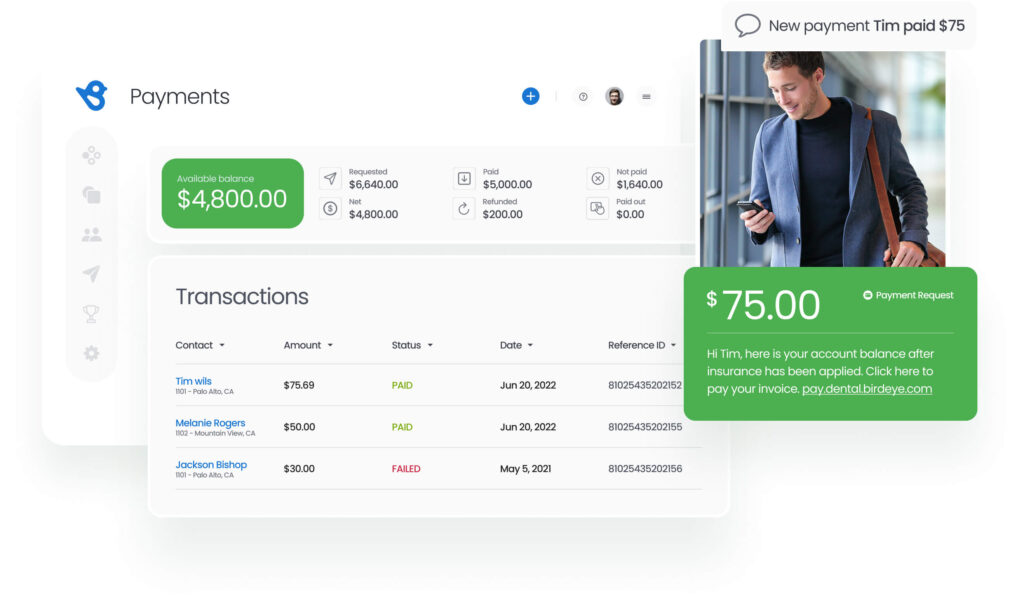
17. Upsell and cross-sell emails
Upsell and cross-sell emails are powerful touchpoints that should be approached with care. Rather than just promoting more products, offer tailored suggestions that meet the customer’s evolving needs.
For instance, a customer who buys a laptop might be interested in a tailored follow-up email suggesting accessories like a wireless mouse or laptop sleeve. This way, by presenting contextually relevant products or services, you demonstrate that you understand their needs and preferences and are committed to their long-term satisfaction.
18. Loyalty programs
Loyalty programs are one of the most effective ways to turn one-time buyers into loyal returning customers. By offering exclusive rewards or points for repeat purchases, you incentivize customers to continue making purchases. Well-structured customer loyalty programs not only drive sales but also create an emotional connection that makes customers feel valued. When customers know that their ongoing support is rewarded, they’re more likely to return and become advocates for your brand.
19. Customer feedback surveys
Feedback is invaluable. By implementing customer feedback surveys, brands can get direct insights into how customers feel about their purchase experience. With solutions like Birdeye Survey AI, businesses can scale this process and collect authentic sentiment data. Analyzing feedback enables you to identify patterns in customer satisfaction or pinpoint areas that require attention. This real-time data empowers your service team to make timely adjustments, thereby improving the overall customer experience and influencing subsequent customer touchpoints.
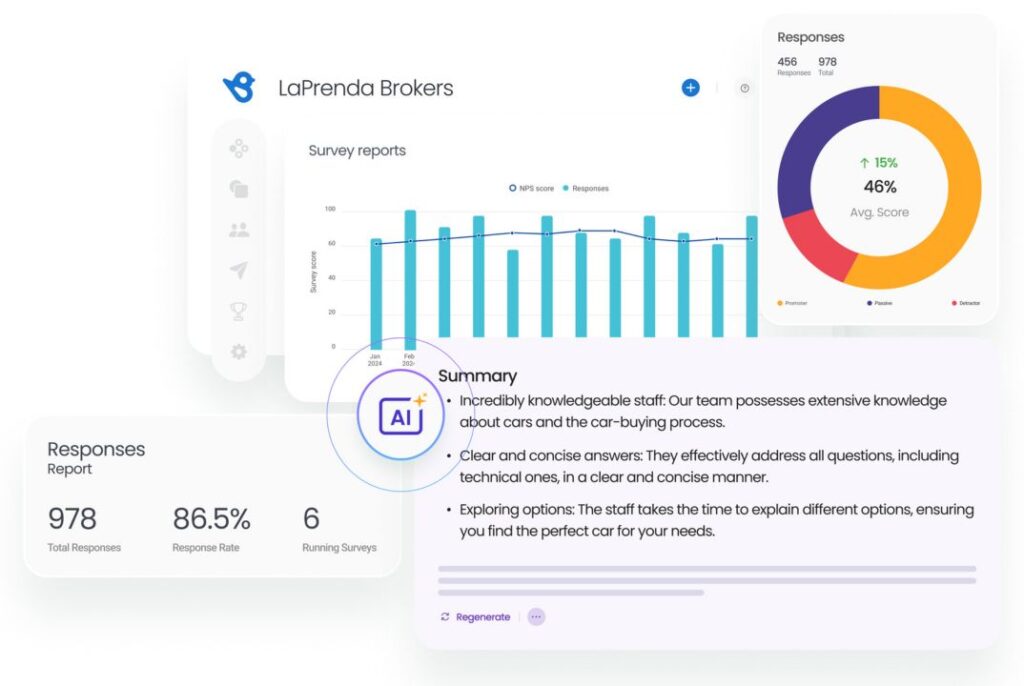
Each of these customer touchpoint examples provides essential opportunities to interact with your brand in ways that not only meet but exceed customer expectations.
Now, let’s explore the customer service touchpoints that drive customer retention.
Customer service touchpoints that impact retention
Customer service touchpoints are crucial in establishing and maintaining lasting relationships with your customers. These interactions foster trust, enhance loyalty, and ensure that both new and existing customers continue their journey with your brand.
Here are key service touchpoints that directly impact retention:
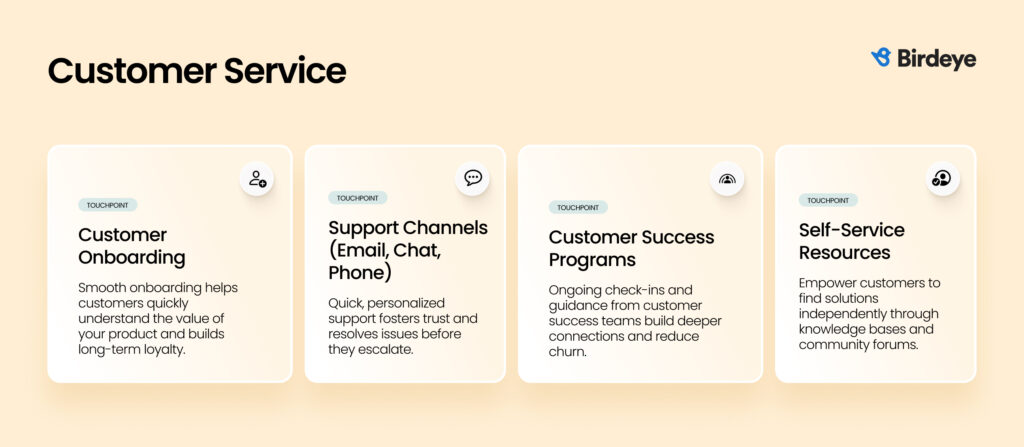
20. Customer onboarding
Effective onboarding is critical in the early stages of a customer’s journey. When customers fully understand the value of your product from the start, it sets the stage for a lasting relationship. A smooth and informative onboarding experience can help customers prefer your brand and ensure they feel confident in their decision.
21. Support channels (email, chat, phone)
Quick, personalized service through email, chat, or phone can transform frustrated customers into loyal advocates. For example, a quick resolution over live chat for a delayed order can leave a stronger impression than a refund processed via email days later. Moreover, when your service team responds promptly and addresses concerns with empathy, it shows that you value your customers’ time and needs, turning challenges into opportunities for strengthening trust.
22. Customer success programs
Ongoing engagement through customer success programs is essential for reducing churn. Regular check-ins and proactive guidance from your customer success team not only elevate the customer experience but also foster deeper connections, helping customers feel supported and heard long after their initial purchase. These programs play a key role in driving business growth by encouraging subscription renewals and increasing customer loyalty.
23. Self-service resources
Empowering your customers to find solutions independently can significantly enhance their overall satisfaction, retention, and loyalty. Self-service tools like knowledge bases, how-to videos, and community forums empower customers to resolve issues independently. This not only reduces support load but also strengthens their trust in your brand, as they feel equipped to navigate your product or service without friction.
How Birdeye helped South Georgia Dental optimize touchpoints

The brand
South Georgia Dental, born from the merger of three leading dental practices, has evolved into a multi-location healthcare brand that prioritizes service, technology, and patient-centric care.
The challenge
They lacked a consistent, proactive system to collect reviews, understand sentiment, and drive engagement across 88 locations.
The solution
Partnering with Birdeye, they deployed Birdeye Reviews AI, Birdeye Surveys AI, and Birdeye Social AI to:
- Automate post-appointment feedback requests.
- Collect and analyze patient sentiment.
- Build localized review profiles.
- Bulk-generate and schedule social posts.
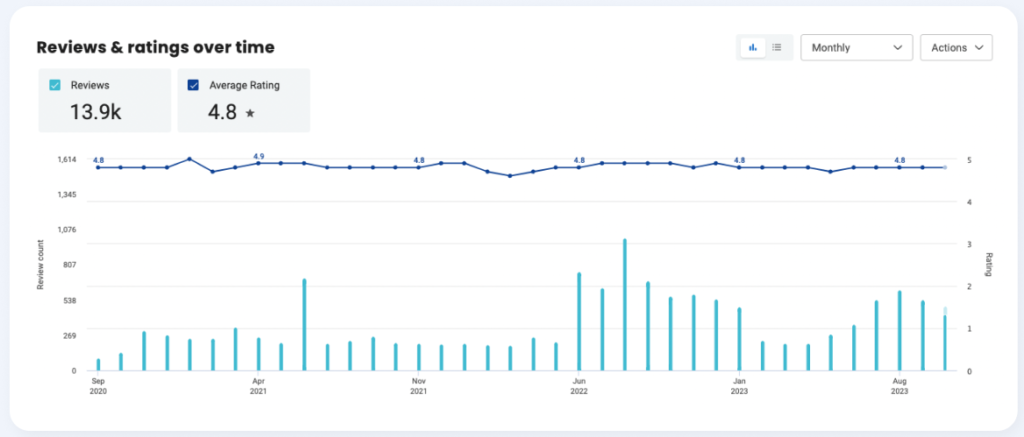
The result? A 1673% increase in reviews, 13.9K new reviews generated, a 4.8-star average rating, and millions of Google profile impressions.

Learn more about Birdeye and South Georgia Dental case study
How to identify customer touchpoints in your business
Here are some effective strategies to identify customer touchpoints:
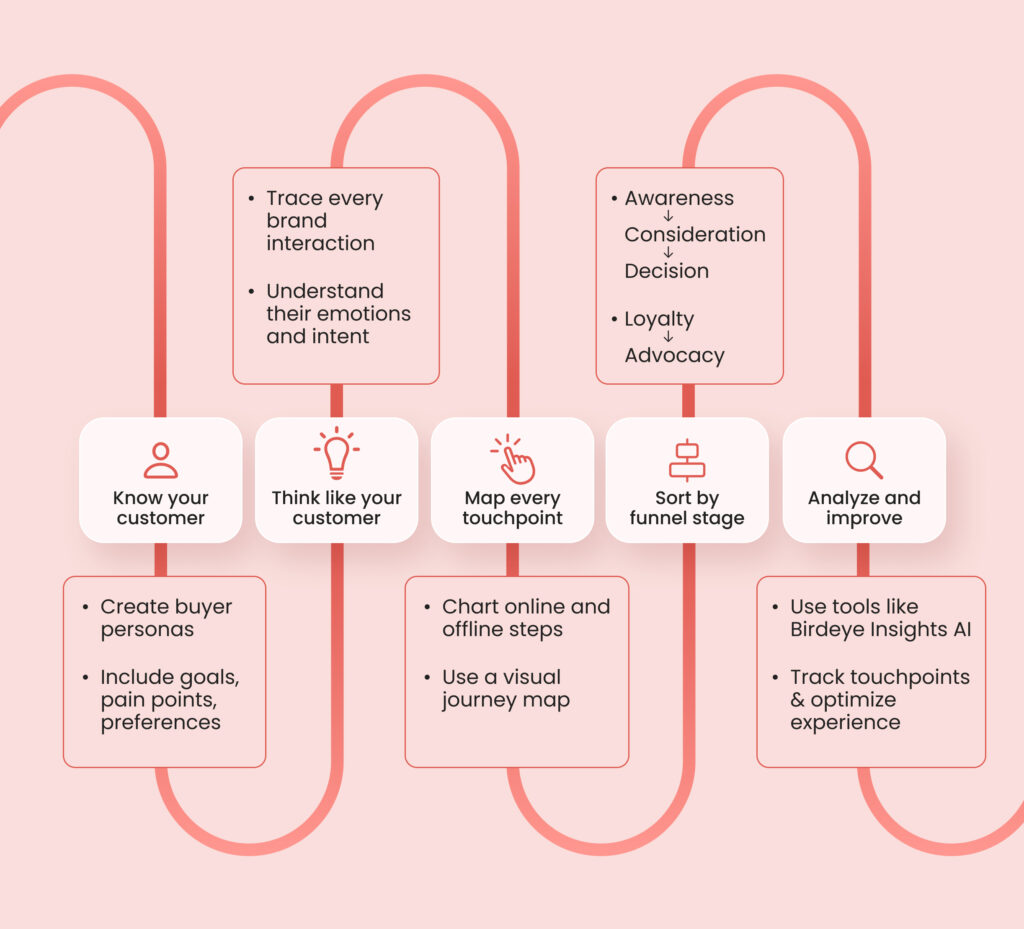
1. Identify your target audience
Create buyer personas that reflect your ideal customer. Understand their demographics, preferences, and pain points. By defining who your customers are, you can better tailor your customer touchpoints to their needs and expectations, ensuring a more personalized experience.
2. Think like your customer
Step into your customers’ shoes to truly understand their experience. Where and how do they interact with your brand? What emotions do they experience at each stage of the journey? By aligning with their perspective, you can create a customer experience that resonates.
3. Map interactions across the customer journey
Use a customer journey map to identify all the points where customer interactions occur, both online and offline. This visual representation allows you to track each touchpoint, ensuring you don’t miss any crucial moments that can influence customer satisfaction.
Optimize touchpoints for loyalty and growth.
Want to see the impact of Birdeye on your business? Watch the Free Demo Now.
4. Group and categorize by funnel stage
Organize touchpoints based on where they occur in the funnel:
- Awareness – The customer becomes aware of your brand.
- Consideration – They evaluate your products or services.
- Decision – They make a purchase.
- Loyalty – They return for more and build a relationship with your brand.
- Advocacy – They promote your brand to others.
This helps reveal areas that need attention and highlights where you can prioritize actions to increase customer satisfaction and drive conversions.
5. Use tools to analyze touchpoint quality
Leverage platforms like Birdeye’s Insights AI, which tracks customer journey touchpoints across different locations, channels, and competitors. This enables your customer service team to gain in-depth insights into customer behaviors and trends, allowing you to optimize your strategy and enhance the overall customer experience.
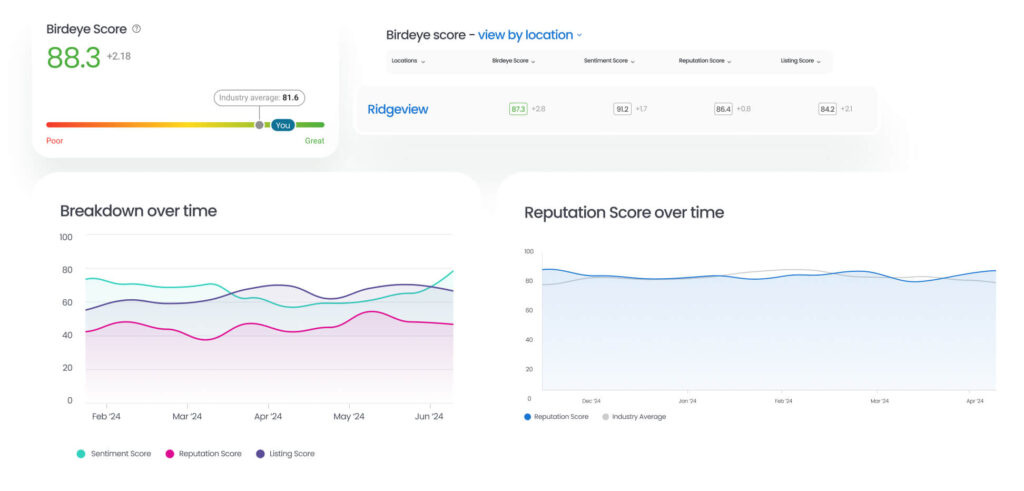
How to build an effective customer touchpoint strategy for growth
Once you’ve identified your key customer touchpoints, it’s time to craft a strategy that drives growth and improves customer engagement at every step.
Here are five essential ways to build an effective customer touchpoint strategy:
1. Track every customer touchpoint with surveys and experience metrics
Track every customer touchpoint using customer touchpoint surveys and customer experience metrics such as Net Promoter Score (NPS), Customer Satisfaction Score (CSAT), and Customer Effort Score (CES).
By gathering customer feedback at each interaction, you can gain valuable insights into how customers perceive their journey with your brand. These metrics help identify areas of improvement, ensuring that you consistently meet customer expectations and enhance their overall experience. Regular tracking allows you to fine-tune your approach, optimize touchpoints, and drive long-term customer satisfaction.
2. Prioritize the most influential moments
Focus on the customer touchpoint examples that have the greatest impact on customer decisions, such as pricing, product reviews, and the onboarding process. These touchpoints can significantly affect whether customers continue their journey with your brand or not. Ensure these moments are flawless to boost conversion rates and improve customer satisfaction.
3. Align brand tone and messaging across touchpoints
Consistency in your messaging is essential for delivering omnichannel experiences. Whether through social media posts, customer surveys, or online advertising, ensure your tone reflects your brand’s values. This alignment fosters trust and strengthens your connection with your target audience across all channels, creating a seamless and cohesive brand experience that drives long-term business success.
4. Automate repetitive tasks
Streamline processes by automating tasks such as post-purchase emails and reminders for subscription renewals. By doing this, you save time, reduce human error, and maintain a personalized experience. Automation ensures that your service team focuses on more complex interactions while repetitive tasks continue to add value to your customer touchpoints.
Pro Tip: With Birdeye Payments, automate your entire payment process. Offer flexible billing options and streamline collections with automated payment reminders, making it easier for customers to pay and for you to get paid faster.
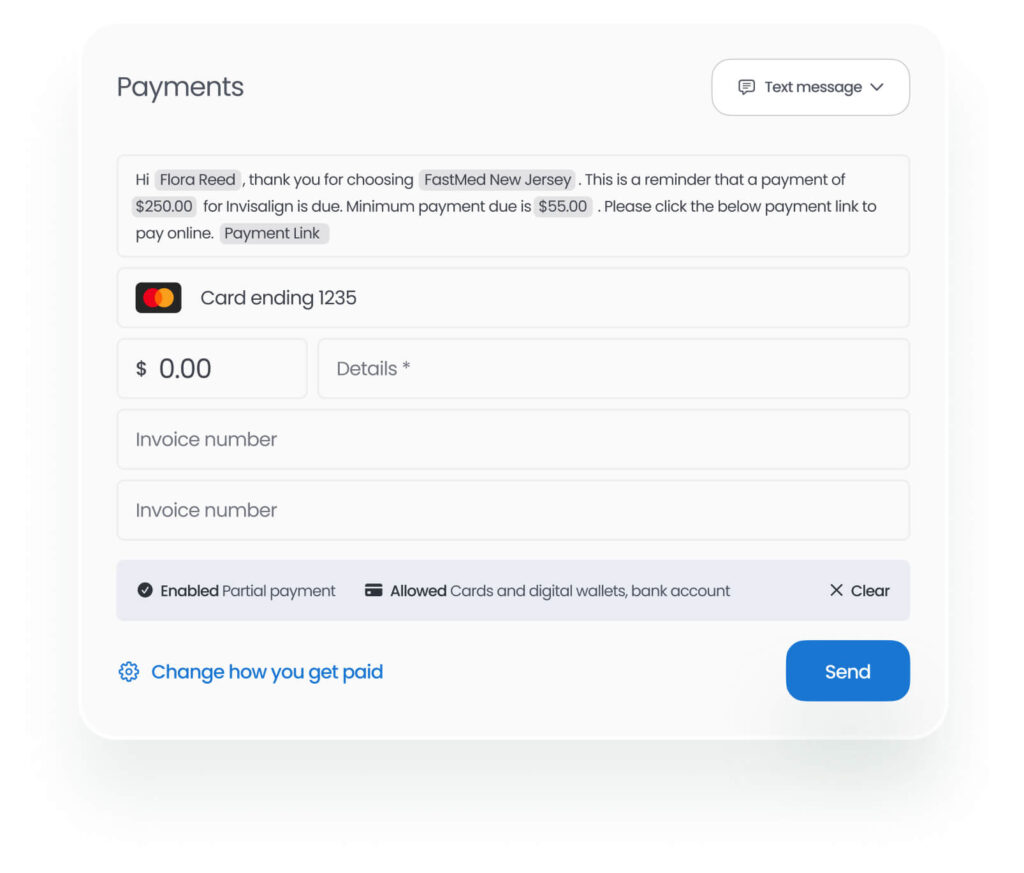
5. Train your customer support team to recognize emotional signals
Your service team plays a crucial role in improving customer engagement. Training them to recognize and respond to emotional cues from customers enables the delivery of more personalized service. Understanding customer emotions can lead to more effective resolution of issues, ultimately strengthening brand loyalty.
Note: Don’t forget to reevaluate your touchpoints on a quarterly basis. As customers engage in new ways (e.g., through a new social media platform), your map must evolve accordingly.
Leverage Birdeye solutions to scale touchpoint success
Automation and GenAI let you scale personalized experiences across all customer interactions.
Here’s how Birdeye fits into your digital touchpoint strategy:
- Birdeye Reviews AI: Monitors 200+ review sites and generates AI-crafted responses.
- Birdeye Survey AI: Collects emotional feedback and provides actionable data.
- Birdeye Social AI: Creates, analyzes, and schedules local social media content.
Pro Tip: Birdeye social publishing automates content planning by generating brand-consistent, hyperlocal posts tailored to each location. Set your preferences for approval, scheduling, and publishing times to save time, maintain consistency, and boost engagement across all locations.
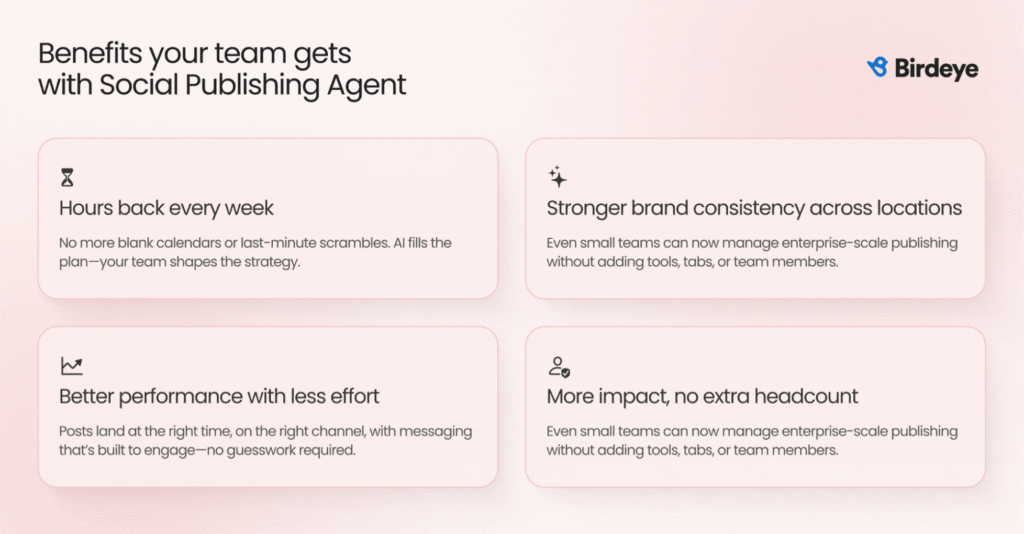
- Birdeye Insights AI: Tracks reputation trends and suggests improvements.
- Birdeye Competitor AI: Benchmarks sentiment, experience, and overall reputation against rivals.
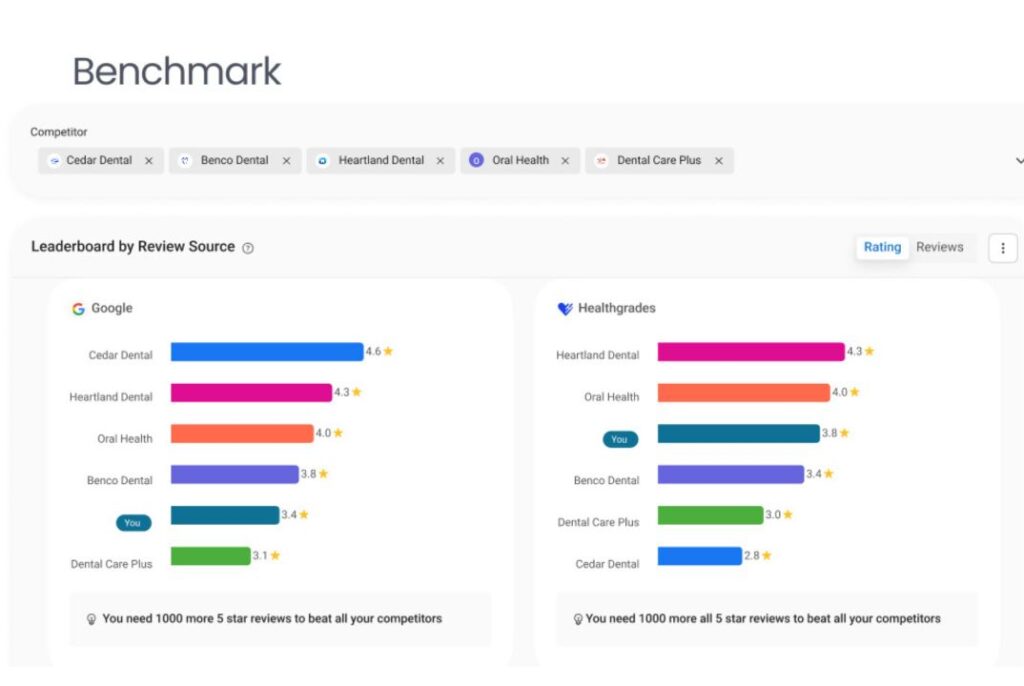
Worth noting: You can now understand emotion, brand perception, and performance trends from one dashboard and act on them.
FAQs: Everything you need to know about customer touchpoints
Customer touchpoints refer to all the moments a customer interacts with your brand throughout their customer journey. These range from ads and website visits to reviews, onboarding, and support.
Use a customer journey map and analyze data from social media, website traffic, chat logs, and surveys. Solutions like Birdeye Insights AI and Birdeye Survey AI can help track customer experience touchpoints and their emotional impact.
They directly influence how customers feel about your brand. Optimizing these moments helps improve loyalty, reduce churn, and increase customer satisfaction.
B2B customer journey touchpoints often involve longer sales cycles, more stakeholders, and a stronger focus on education and service (e.g., onboarding, webinars, and CS check-ins).
Absolutely. Every customer touchpoint example offers insight into what customers expect, prefer, or dislike. Use that to refine your business strategy, content, and revenue model.
Harness the power of touchpoints to accelerate business growth
With the right strategy and the right tools, each customer touchpoint becomes an opportunity to exceed expectations and build long-term loyalty.
By stepping into your customers’ shoes, you can better understand their needs and deliver personalized experiences that leave a lasting impression.
Birdeye provides the insights, automation, and control you need to optimize every interaction, whether it’s through your customer service team, engaging social media posts, or other key touchpoints in the journey.
By leveraging Birdeye’s effective GenAI solutions, you can turn every moment into a growth driver, fostering customer loyalty and satisfaction at every stage.
Start your customer journey with Birdeye today and transform your customer interactions into your greatest competitive advantage. Watch a demo now.

Originally published









